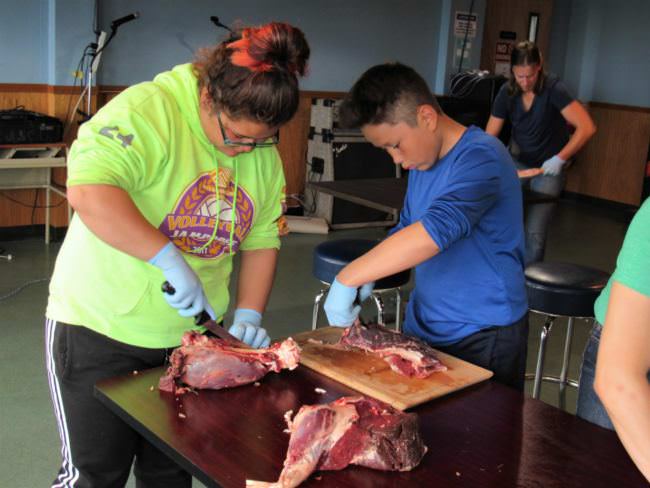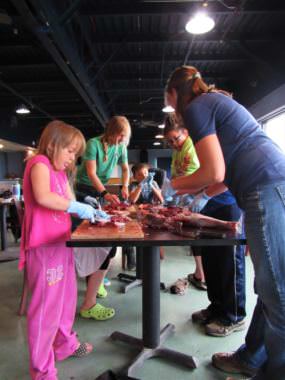
For the last century, reindeer have roamed St. Paul Island without much oversight. But now, the tribal government is stepping up its management style — to boost subsistence options and the local economy.
Fleshy red reindeer quarters are spread across the tables of St. Paul’s tavern. Surrounding them are eager preteens, wielding knives and wearing plastic gloves.
“I don’t think we can cut through this bone!” says one student, “It’s like that thick.”
“No! You don’t want to cut through the bone,” the instructor replies.
The kids are learning how to butcher a hind shank — how to feel along the bone with their fingertips, slice through the tendons and free the best cut of meat.
Lauren Divine is one of the instructors at “reindeer camp” — the first of its kind for the small island of 500 people.
“Just having a first shot at reindeer camp out here is a really big step for us,” she says.
Specifically, it’s a step towards an active management program for the island’s herd. Even though reindeer have lived on St. Paul for about 100 years, the tribe hasn’t done much more than distribute hunting permits. That’s slowly beginning to change — because the community needs another consistent source of meat.
“Especially in light of other resources that are declining,” Divine says. “The struggle becomes greater every year.”

So, tribal leaders have started investigating ways to develop reindeer as a robust option for subsistence. They’re experimenting with different hunting seasons and harvest strategies in addition to offering community education, like this camp.
“We’re at the starting line, whereas a lot of other places in Alaska are more developed or have these champions who have been around for a long time in the reindeer world,” Divine says. “We’re building our knowledge base from the ground up.”
That’s clear from the dozen or so kids at camp. Most are pretty new to the animal, including 9-year-old Riley Melvidov, who says his dad only hunted reindeer once. His family liked the meat, he says, and they liked having a stash of it in the freezer, alongside their fur seal and other more established subsistence foods.
Riley’s family isn’t the only one interested. Tribal leaders say more and more people are picking up permits, heading out on the tundra and taking a shot at reindeer hunting.
Eventually that participation could translate into something more profitable, according to Erin Carr, who works for the Reindeer Research Program at the University of Alaska Fairbanks.
“They have an opportunity to be able to sell the reindeer meat in the store,” she says.
She’s partnering with the tribe to expand St. Paul’s economy — and freezer section — through commercial sales at the local grocery store. It’ll take a while, but Carr says the program would let people support the island’s hunters while avoiding the astronomical prices of other meat.
Back at reindeer camp, the kids finish their butchering lesson and shed their bloody gloves. They gather around the grill in silent excitement, while their cuts of meat are seared on both sides.
Finally, the reindeer is served up, the taste test begins — and the reviews are positive.
“Really good!” says one student. “You want to try?”
